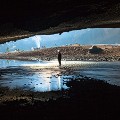
Photos:
Hang En campsite – The first and last nights of the expedition are spent camping inside Hang En, which is considered to be one of the most spectacular campsites in all of Asia.
Hide Caption
Cave pearls – Not all of the magnificent formations that can be found in Hang Son Doong are massive. Towards the end of the chambers rare, spherical "cave pearls" are also found. These are formed when tiny pieces of sediment collect calcium salt layers over thousands of years.
 Entering the jungle – Hang Son Doong is so massive that it contains its own jungle, underground river and localized weather system. Clouds form inside the cave and spew out from the exits and dolines, which gave the first explorers a clue as to how large Hang Son Doong really is.
Entering the jungle – Hang Son Doong is so massive that it contains its own jungle, underground river and localized weather system. Clouds form inside the cave and spew out from the exits and dolines, which gave the first explorers a clue as to how large Hang Son Doong really is. Narrow Hang En – A narrow passageway connects the two sections of Hang En.
Ban Doong elders – There is only one village inside the Phong Nha-Ke Bang National Park, known as Ban Doong. Around 40 Bru-Van Kieu ethnic minority people live in this isolated location, which can only be reached by foot. The two elders of the village happily welcome trekkers who must pass through their humble home to reach Hang E and Hang Son Doong.
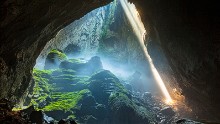
Photos:
Phong Nha-Ke Bang National Park – Vietnam's Phong Nha-Ke Bang National Park is home to the world's largest cave -- a place few people have visited. Click through the gallery to see more images of this amazing underground world. This image shows how collapses caused by erosion leave openings through which incredible sunbeams penetrate, creating mesmerizing light shows.
Stargazing – From the second campsite inside Hang Son Doong visitors can stare out of an erosion hole (these are known as "dolines") and catch stars glistening on a clear night.
Porter Trail – A strong crew of 20 porters, three guides, two caving experts, two chefs and two national park rangers assist on every expedition to Hang Son Doong. Just like the sherpas of Nepal it's the porters of Phong Nha who are the unsung heroes that make the adventure possible.
Abseiling into darkness – Sections of Hang Son Doong are so steep and perilous that ropes are required to help lower people safely through them.
Hang En exit – The enormous exit of Hang En, the third largest cave in the world, is more than 120-meter high and 140-meter wide.
Doline 2 Campsite – The climb down from a section known as the "Garden of Edam" leads to the second campsite in Hang Son Doong.
Photos:
Fancy footwear – While most people who take the five-day expedition to Hang Son Doong invest in high quality equipment and clothing, the porters and guides of Phong Nha prefer to do the trek in pairs of plastic sandals that are bought in the local market for $2.
Photos:
End of Son Doong – Limestone formations such as stalagmites and stalactites are formed when water containing dissolved calcium carbonate drips through the cave's ceiling and creates minuscule rings. Over millions of years, these tiny minerals grow in a collection of striking and often beautiful shapes.
Photos:
 Rao Thuong River – The Rao Thuong River flows fast through the Son Doong cave system, continuously carving new chambers and passages. During the wet season the river floods to dizzying levels, halting any chance of exploration through the caves or jungle.
Rao Thuong River – The Rao Thuong River flows fast through the Son Doong cave system, continuously carving new chambers and passages. During the wet season the river floods to dizzying levels, halting any chance of exploration through the caves or jungle. Photos:
Hang En campsite – The first and last nights of the expedition are spent camping inside Hang En, which is considered to be one of the most spectacular campsites in all of Asia.
Photos:
Arm wrestling – Entertainment comes in many forms when you spend days on end inside a cave. Card games are popular, as is singing songs and drinking potent, locally brewed rice wine. The Vietnamese porters take pride in their strength and agility and are constantly challenging each other to show off their skills.
Photos:
Cave pearls – Not all of the magnificent formations that can be found in Hang Son Doong are massive. Towards the end of the chambers rare, spherical "cave pearls" are also found. These are formed when tiny pieces of sediment collect calcium salt layers over thousands of years.
Photos:
Entering the jungle – Hang Son Doong is so massive that it contains its own jungle, underground river and localized weather system. Clouds form inside the cave and spew out from the exits and dolines, which gave the first explorers a clue as to how large Hang Son Doong really is.
Narrow Hang En – A narrow passageway connects the two sections of Hang En.
Photos:
Ban Doong elders – There is only one village inside the Phong Nha-Ke Bang National Park, known as Ban Doong. Around 40 Bru-Van Kieu ethnic minority people live in this isolated location, which can only be reached by foot. The two elders of the village happily welcome trekkers who must pass through their humble home to reach Hang E and Hang Son Doong.
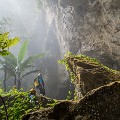
Photos:
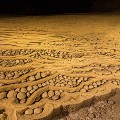 Phong Nha-Ke Bang National Park – Vietnam's Phong Nha-Ke Bang National Park is home to the world's largest cave -- a place few people have visited. Click through the gallery to see more images of this amazing underground world. This image shows how collapses caused by erosion leave openings through which incredible sunbeams penetrate, creating mesmerizing light shows.
Phong Nha-Ke Bang National Park – Vietnam's Phong Nha-Ke Bang National Park is home to the world's largest cave -- a place few people have visited. Click through the gallery to see more images of this amazing underground world. This image shows how collapses caused by erosion leave openings through which incredible sunbeams penetrate, creating mesmerizing light shows.Stargazing – From the second campsite inside Hang Son Doong visitors can stare out of an erosion hole (these are known as "dolines") and catch stars glistening on a clear night.


Porter Trail – A strong crew of 20 porters, three guides, two caving experts, two chefs and two national park rangers assist on every expedition to Hang Son Doong. Just like the sherpas of Nepal it's the porters of Phong Nha who are the unsung heroes that make the adventure possible.
Photos:
Abseiling into darkness – Sections of Hang Son Doong are so steep and perilous that ropes are required to help lower people safely through them.
Photos:
Hang En exit – The enormous exit of Hang En, the third largest cave in the world, is more than 120-meter high and 140-meter wide.
Photos:
Fancy footwear – While most people who take the five-day expedition to Hang Son Doong invest in high quality equipment and clothing, the porters and guides of Phong Nha prefer to do the trek in pairs of plastic sandals that are bought in the local market for $2.
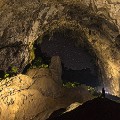 End of Son Doong – Limestone formations such as stalagmites and stalactites are formed when water containing dissolved calcium carbonate drips through the cave's ceiling and creates minuscule rings. Over millions of years, these tiny minerals grow in a collection of striking and often beautiful shapes.
End of Son Doong – Limestone formations such as stalagmites and stalactites are formed when water containing dissolved calcium carbonate drips through the cave's ceiling and creates minuscule rings. Over millions of years, these tiny minerals grow in a collection of striking and often beautiful shapes. (CNN)"Watch out for dinosaurs."
I smile at our guide's warning and enter the lush jungle growing inside Hang Son Doong, a three-million-year-old cave in central Vietnam.
Water drips from a gaping scar in the ceiling over 100 meters above us. A spectacular sunbeam starts to creep down the side of the serrated cliffs.
The shrill call of birds and macaque monkeys echoes off the limestone, drifting in from the unseen world beyond the skylight.
"Watch out for dinosaurs. That's what we called this place when we first discovered it," , caving expert Howard Limbert, elaborates. The prehistoric atmosphere made the reference obvious.
We continue on, stepping deeper into the void that is the largest cave in the world.
The discovery
Located in the heart of the UNESCO-listed Phong Nha-Ke Bang National Park in Vietnam's Quang Binh province, Hang Son Doong is one of the most captivating adventures that can be experienced in Southeast Asia.
More people have stood on the summit of Mount Everest than have witnessed the surreal beauty inside these enormous chambers.
Translated as Mountain River Cave, it was first discovered in 1990 by Ho Khanh, a local farmer who was seeking shelter from a passing storm in the jungle.
He noticed clouds and the sound of an underground river gushing from a large hole in the limestone, and reported his findings to the British Caving Research Association (BCRA), who were stationed in Phong Nha at the time.
Unfortunately Ho Khanh lost his bearings during his return, and the exact location of the cave remained lost for 18 years.
In 2008 while hunting for food he stumbled across the entrance again, and returned the following year with Howard and Deb Limbert from the BCRA.
They began the exploration of the cave, and in 2010 determined it to be the largest ever discovered.
The news shook the caving world.
The expedition to Hang Son Doong
Stretching more than five kilometers long and reaching heights of 200 meters, the main cavern of Hang Son Doong is large enough to house an entire New York City block.
In 2013 Hang Son Doong was opened to the public for the first time, with the adventure tour company Oxalis running the exclusive five-day expedition.
Limiting the tour to only one operator has protected the cave from mass development. Only 10 customers per departure are permitted. Tours run once per week between February to August per year.
The eco-system inside Hang Son Doong is as unique as it is large, and it even has its own localized weather system.
Rare limestone cave pearls are scattered in dried pools, and the largest stalagmite ever found stands 80-meter tall.
Collapsed ceilings have created openings known as dolines, allowing foliage to grow inside the cave. Microscopic organisms thrive in the darkness.
The journey to Hang Son Doong is not for the faint-hearted. Involving two days of intense jungle trekking and river crossings to reach the entrance, nights are spent camping inside the cave and the nearby Hang En, now known to be the third largest cave in the world.
Once inside hikers are expected to abseil, climb, crawl and swim through underground rivers to arrive at the end of the cave. It's an adventure like no other.
Despite the physical demands guests are perfectly cared for, two caving experts, three local guides, two chefs, two park rangers and 20 porters join every expedition.
The scale of the operation is phenomenal, and this ensures everyone's safety and welfare, along with the preservation of the cave, is looked after with expert precision.
New discoveries
Besides the fantastic experience and unique beauty of this adventure, the journey to Hang Son Doong has resulted in a growing industry that has improved the lives of many -- tourism.
The Quang Binh province has long been one of the poorest regions in the country, and was heavily bombed during the Vietnam War.
Unexploded ordnance are scattered throughout the fields and jungle, putting thousands of lives at risk every single day.
Many of the locals collect and dismantle these unexploded bombs, selling the dynamite and metal for scrap.
Countless lives have been lost doing this dangerous practice, but for some there were no other options to help feed their families.
When the colossal caves of Phong Nha were discovered travelers began arriving for the first time.
Villagers embraced this new opportunity and started focusing on tourism. The positive results has seen the local economy flourish.
New community homestays are being built, and the once-impoverished town has been given a new life.
The recent discovery of 57 new caves has also excited the inhabitants of Phong Nha, who have seen their small village quickly become the adventure capital of Southeast Asia.
Passionate locals have created mountain biking, hiking, kayaking and eco-conservation tour companies to run alongside the caving.
Delicate ecosystem
However a new threat has emerged in recent years, which may compromise the integrity and environmental splendor of the area.
The Vietnamese development company Sun Group has been pushing to build a cable car to Hang Son Doong, which could potentially ferry 1,000 visitors an hour to the cave.
Staunch opposition from UNESCO and activist group Save Son Doong encouraged the Vietnamese government to temporarily halt the construction permits in 2015.
Some argue that this increase in tourism will continue to benefit the local community, while others fear for the destruction of the ecosystem that increased traffic will bring.
Similar projects on Mount Fansipan, the highest mountain in Vietnam, and in Halong Bay have resulted in dramatic environmental damage.
Will history repeat itself with the world's largest cave?
The cable car development continues to loom in the background, and no one knows whether approval will eventually be given.
As one of the last truly pristine environments in the region, Hang Son Doong is a place so remarkable that it demands protection.
One can only hope that a sustainable and responsible decision is made in these critical months.
For now the locals of Phong Nha relish in this new opportunity that the colossal caves have given them, and Hang Son Doong remains as beautiful as ever.


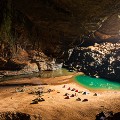
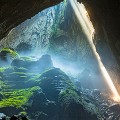
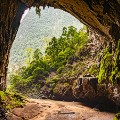

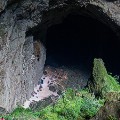




0 comments:
Post a Comment
feel free to tell us what you think below